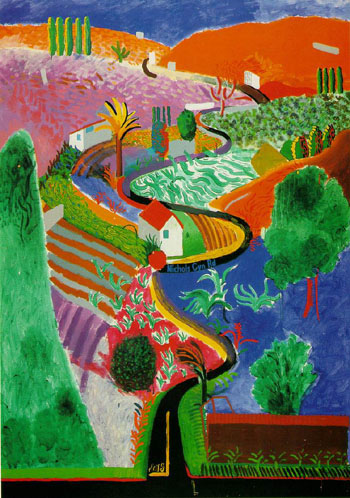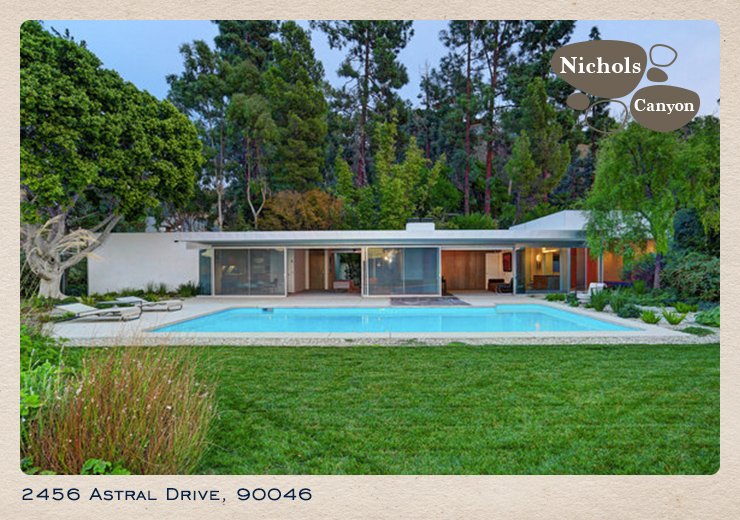
One of the most influential architects of the twentieth century, Richard Neutra helped define modernism not only in Southern California but also around the world.

For an architect who is famous for his use of light and the natural beauty of site—hills, canyons, and wooded areas—he embraced technology as a way to achieve a connection to nature. According to Neutra scholar, Barbara Lamprecht, his philosophy of “biorealism” sought to use biological sciences in architecture “so that design exploited, with great sophistication, the realm of the senses and an interconnectedness to nature that he believed fundamental and requisite to human well-being.”

The Loring House is located in the desirable Nichol’s Canyon area of the Hollywood Hills. Perched on top of a knoll up a long private drive, the home has 5 bedrooms and 4.5 bathrooms on 0.65 acres. The boxcar-style residence contains the original 3 bedrooms and 2.5 baths with a later master suite addition implemented by the firm Escher GuneWardena using Neutra’s original plans.

A separate two-bedroom, two-bath guesthouse with a two-story art studio designed by Steven Ehrlich nestles nearby. Asking price for the .65-acre property is $5.625 million.

Eugene Loring with Audrey Hepburn
Eugene Loring is best known as the choreographer of Billy the Kid, the American classic he created in 1938, which is still in the active repertory of American Ballet Theater. Working between New York and Los Angeles, Loring was directing and choreographing for film and television when he commissioned Neutra to build him a home in the Hollywood Hills.

Loring worked with some legendary talents: Fred Astaire, Cyd Charisse, and Audrey Hepburn to name only a few. His most notable films include: Silk Stockings, Funny Face, and the Ziegfeld Follies.

Nichols Canyon, named after John G. Nichols, mayor of Los Angeles between 1852 and 1853, is one of the most desirable areas in the Hollywood Hills. The road starts at Hollywood Boulevard and snakes its way north into the hills below Mulholland Drive.

Nichols Canyon has a natural, year-round, spring-fed creek and water fall over 60 feet high, and several natural and man-made waterfalls. The stream that flows through the bottom of Nichols Canyon attracts coyotes, frogs, deer, raccoons, skunks, rabbits and other wildlife. Hawks can be seen circling the area as well.

The eclectic neighborhood is a magnet for creative types. The home itself has a pedigree of famous photographers, cinematographers, and film directors who have cherished it over the years. Celebrities like Ava Gardner and Steve McQueen have lived in the area and the British artist, David Hockney, immortalized it with his famous painting, Nichols Canyon.

“Nichols Canyon” by David Hockney 1980 Acrylic on canvas

The home’s distinctive architectural elements include a spider leg column facade, over-sized retractable glass doors, broad roof overhand, and concrete slab floors.

Neutra’s bright, airy homes are seen as the pinnacle of modernism and desirability. And his design philosophy of bringing the outside inside is confirmed in the magnificent living room where the manicured lawn, canyon views, and professionally landscaped gardens become part of the room.


A classic Neutra designed fireplace provides a sculptural focal point in the living room. While outside, a private bamboo garden supplies the requisite natural element.

In fact, all of the rooms have a front-row seat to the garden and canyon views—even the kitchen.

The master suite addition—the Baskerville Addition by Escher GuneWardena—takes Neutra’s original plans into consideration creating a space sympathetic with the existing house yet possessing an architectural identity of its own.

Enclosed on three sides, the fourth side is entirely glass with controlled views of the garden and pool and is more sheltered and quiet.

Within the space a floated unit sheathed in wood contains the toilet and storage. The far end of the space has a continuous skylight that illuminates a glass partition and the wet area of the shower and sink.

The property also features a 2-bedroom guesthouse—the Kalfus Guest House—with a two-story art studio designed by Steven Ehrlich, FAIA.


Time magazine put Richard Neutra on the cover of its August 15, 1949, issue calling him “a prophet of clean, crisp modernism”.
His houses, most of which were built in California, have inspired countless architects and have thankfully managed to avoid the wrecking ball in a city more than happy to destroy its own history. Why? Time offered an answer, “Their beauty, like that of any sea shell, is more than skin-deep—practical, not pretentious.”
~ Listing courtesy of Steve Frankel, Coldwell Banker

Leave a Reply
You must be logged in to post a comment.